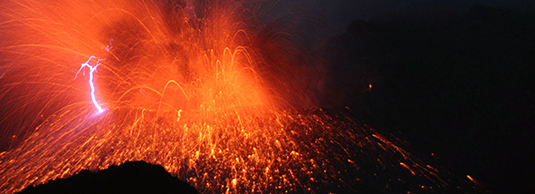
An LMU team has, for the first time, created volcanic lightning in the lab and captured it on film. The new findings may permit rapid characterization of ash clouds released by volcanic eruptions and improve forecasting of their behavior.
When the Icelandic volcano Eyjafjallajökull erupted in April 2010, launching a towering column of ash into the skies, the cloud was observed to be laced with lightning flashes. LMU volcanologists led by Professor Donald Dingwell, Director of the Department of Earth and Environmental Sciences at LMU, have now generated such volcanic lightning in the laboratory, as they report in a recent issue of the journal Geology. “Our experiments demonstrate that there is a relationship between the concentration of fine particles in the ash plume and the number of flashes produced,” says departmental researcher Dr. Corrado Cimarelli.
Turbulence and particle charging
The volcanologists performed their experiments with natural ash obtained from several volcanoes, including Eyjafjallajökull. The ash was loaded into a shock tube and subjected to the kinds of pressures found in the magma chambers of active volcanos just prior to an eruption. Upon sudden decompression, the ash is expelled vertically in a turbulent plume made up of a mixture of gas and solid particles of ash. And indeed, the researchers observe lightning flashes, on the order of tens of centimeters in length, within the column, where collision and fragmentation of ash particles leads to the creation of charged surfaces. When oppositely charged surfaces interact, the electrical energy is dissipated as lightning.
The team recorded the dynamics of the process with the help of high-speed cameras which can capture motions that are imperceptible to the naked eye. In addition, they measured the distribution of electrically charge using two antennas. Videos of the experiments are available on the website maintained by the Department of Earth and Environmental Sciences.
The new study confirms that the incidence of lightning is related to the relative amount of very fine particles in the plume. The smaller the particles, the larger the number of flashes observed. “That in turn implies that observations of volcanic lightning could allow one to deduce the concentration and size distribution of the ash particles released during an eruption. And that information is crucial for efforts to predict how the particles will behave in the atmosphere, and how they might affect air traffic,” says Corrado Cimarelli. – Everyone remembers the disruption caused to transatlantic and European flight schedules by the clouds of ash released during the eruption of Eyjafjallajökull in April 2010.
The new findings also contribute to a better understanding of the mechanisms that underlie the self-charging of dust particles that are subjected to turbulence. They are thus relevant not only to other atmospheric phenomena, such as sandstorms, but also to industrial processes that involve interactions between mobile streams of particulate matter.









